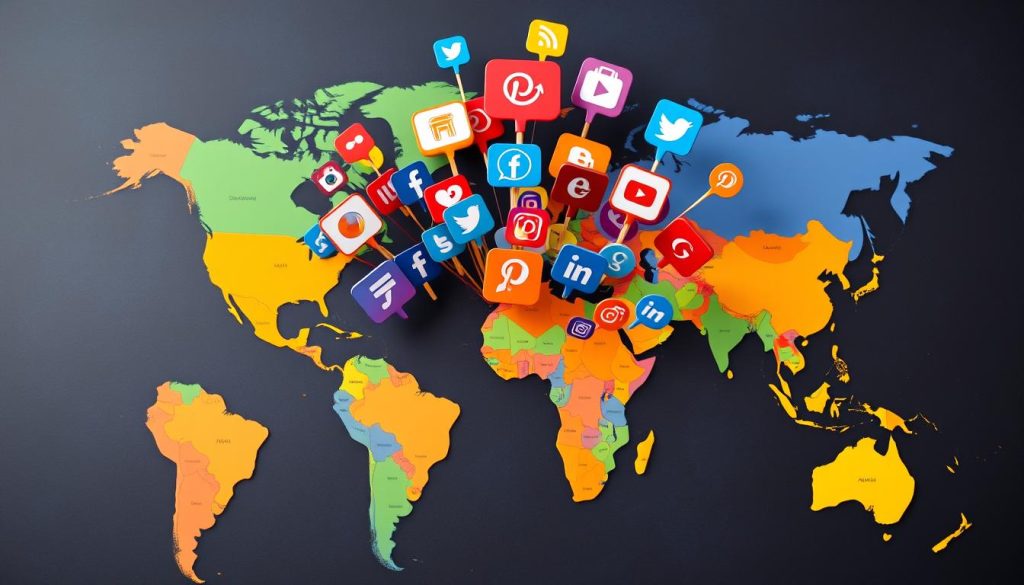Reaching hobbyist communities is vital for software developers and marketers. These passionate groups offer unique chances to showcase your software. You can gather feedback and build a loyal user base through these communities.
We’ll explore effective ways to promote your software to hobbyist communities. Our focus will be on understanding community dynamics and creating engaging content. We’ll also cover leveraging social media and collaborating with influential members.
Key Takeaways
- Understand the unique characteristics and motivations of hobbyist communities
- Identify relevant communities and engage with them authentically
- Develop a content strategy that resonates with hobbyist audiences
- Leverage social media platforms to amplify your software’s visibility
- Collaborate with influential community members to build trust and credibility
- Foster ongoing engagement and community involvement
- Continuously measure and iterate your promotional strategies
Understanding Hobbyist Communities
Hobbyist communities are vibrant ecosystems driven by passion. They’re spaces where enthusiasts share ideas and learn from each other. These communities explore shared interests and values in depth.
Passion-Driven Individuals
Passionate individuals form the core of hobbyist communities. They’ve invested time and effort to become experts in their fields. Their genuine love for their hobbies fuels the community’s growth and energy.
Shared Interests and Values
Shared interests and values unite hobbyist communities. These groups connect people who love vintage cars, model railroading, or photography. They provide space for collaboration and support.
A strong sense of belonging and camaraderie defines these communities. This shared purpose makes them powerful and influential.
“The true value of a hobbyist community lies in the shared passion and enthusiasm of its members, who come together to explore, experiment, and grow their respective interests.”
Grasping hobbyist users’ motivations is key to promoting software to niche audiences. Tap into their passion and address their needs. This approach can create a loyal, engaged user base for your product.
Identifying Relevant Communities
Finding the right hobbyist groups is key to promoting your software. Look for online forums, social media groups, and local meetups. Research these communities to understand their interests and communication styles.
Knowing where your audience gathers will help you reach them effectively. This approach can boost awareness and loyalty for your software.
Online Forums and Groups
Search for platforms where hobbyists discuss their passions. These may include forums, subreddits, or Facebook groups. Find active communities that align with your software’s features.
Join these forums and share helpful content. Build connections with members to gain their trust and interest.
Local Meetups and Events
Don’t forget about local hobbyist communities. Attend or organize workshops and events in your area. Face-to-face interactions can provide valuable insights into your target audience.
These meetings help you gather feedback and build relationships. You can connect with influential community members at these events.

By connecting with the right communities, you’ll reach your target hobbyist audience effectively. This strategy can drive awareness and adoption of your software.
How To Promote Software To Hobbyist Communities
Promoting software to hobbyist communities needs a smart approach. Understanding these passionate users’ needs is crucial. Let’s explore key tactics to reach and engage your target hobbyist audience.
Build a solid product that meets hobbyist needs. Focus on user-centric design and top-notch quality. Hobbyists demand exceptional experiences from their software.
Create engaging content for your audience. Develop tutorials, guides, and demos that address hobbyist interests. This establishes your brand as a trusted resource in the community.
Use social media to reach hobbyist users effectively. Share content, join discussions, and build a community. This helps you connect with your target audience.
Team up with influencers in the hobbyist world. Find credible individuals with strong followings. Explore mutually beneficial relationships to boost your message’s reach.
Engage with the community regularly. Respond to feedback and address concerns promptly. Create a supportive environment where hobbyists feel valued and heard.
These effective tactics for reaching hobbyist users can drive software adoption. Follow best practices for marketing software to hobbyist audiences to succeed in this vibrant community.
“Engaging with your hobbyist audience and fostering a sense of community is key to driving long-term success and loyalty.”
Building a Solid Product
A high-quality, user-centric product is key for promoting software to hobbyist communities. Understanding their unique needs is crucial. Focus on user-centric design and ensuring quality and reliability to create software that resonates with your audience.
User-Centric Design
Consider hobbyists’ interests, goals, and usage patterns when designing software. Gather feedback and incorporate insights into the design process. Tailor features and interfaces to match hobbyist preferences and workflows.
This approach ensures seamless and enjoyable interactions for your users. It helps create a product that truly meets their needs.
Quality and Reliability
Hobbyists value quality and reliability in their software tools. Commit to thorough testing, bug fixes, and ongoing maintenance. Address user concerns promptly and provide responsive support.
Continuously enhance the stability and performance of your software. This dedication will ensure quality and reliability in software for hobbyists.
Building a user-centric software product establishes trust and credibility within the hobbyist community. This solid foundation paves the way for successful promotion and engagement. It drives growth and adoption among hobbyist users.

Creating Engaging Content
Compelling content is vital for promoting your software to hobbyist communities. Engaging tutorials, guides, and demos can showcase your product’s capabilities. These tools can drive interest and adoption among hobbyist users.
Visual content can effectively highlight your software’s user-friendliness. By creating informative materials, you can attract and retain your target audience.
Tutorials and Guides
Develop tutorial-style guides that show how your software enhances the hobbyist experience. Tailor these step-by-step tutorials to your audience’s specific needs and interests. Provide clear instructions to help users maximize your product’s potential.
Visual Content and Demos
Add visually engaging elements like product demos, screenshots, and videos to your written content. These visual aids can effectively communicate your software’s features and benefits. They offer hobbyist users a more immersive and compelling experience.
Use high-quality visuals that showcase your application’s intuitive design and user-friendly interface. This approach can help users better understand and appreciate your software.
| Type of Content | Advantages | Examples |
|---|---|---|
| Tutorials and Guides |
|
|
| Visual Content and Demos |
|
|
“Engaging content is the key to capturing the attention and interest of hobbyist communities. By providing valuable tutorials, guides, and visually compelling demos, you can build trust and showcase the true value of your software.”
Leveraging Social Media
Social media platforms are powerful tools for promoting software to hobbyist communities. Identify channels where your target audience is most active. These may include specialized forums, Facebook groups, or niche-specific platforms.
Share content, foster discussions, and highlight your software’s unique benefits on these channels. Showcase product demos, share educational tutorials, and engage with community members. This approach builds brand awareness and drives user engagement.
“The key to success on social media is to create content that your audience finds genuinely useful and engaging.”
Focus on quality over quantity when engaging with hobbyist communities on social media. Establish your brand as a trusted resource and thought leader. This can increase visibility and attract more users to your software.
| Social Media Platform | Potential Benefits for Hobbyist Communities |
|---|---|
| Online Forums | Allows for in-depth discussions, knowledge sharing, and direct feedback from engaged users |
| Facebook Groups | Facilitates community building, networking, and the sharing of resources and updates |
| Niche-Specific Platforms | Provides a dedicated space for hobbyists to connect, collaborate, and discover relevant tools and solutions |
Strategic use of social media can help you reach and engage your target audience. It fosters a loyal user base and drives growth for your software business.

Collaborating with Influencers
Partnering with influential figures can boost your software’s visibility and credibility. Identify respected experts and active community members with significant followings. Collaborate with them to create content, host events, or provide product reviews.
This strategy can help you reach a wider audience. It can also lend your software an authoritative stamp of approval.
Identifying Key Influencers
Start by finding the most influential voices in your hobbyist community. Look for individuals with large, engaged followings who produce high-quality content. Seek out those respected for their expertise and insights.
These key opinion leaders can help expand your reach. They can also add credibility to your software.
Building Mutually Beneficial Relationships
Focus on creating mutually beneficial relationships with hobbyist influencers. Offer them value, such as exclusive access to your software. Invite them to participate in product development or create co-branded content.
In return, use their influence to increase awareness. Ask for product reviews and build trust within your target community.
| Collaborating with Hobbyist Influencers | Identifying Key Opinion Leaders | Building Mutually Beneficial Relationships |
|---|---|---|
| Leverage influential voices to amplify your software’s visibility and credibility | Look for individuals with a large, engaged following, respected expertise, and high-quality content | Offer value to influencers and create co-branded content to drive awareness and foster trust |
“Collaborating with the right influencers can be a game-changer for reaching and engaging with your target hobbyist community.”
Engaging with the Community
Building a strong community is vital for software developers targeting hobbyist users. Respond actively to feedback, questions, and discussions to show your commitment. This open dialogue helps you understand users better and builds trust.
Responding to Feedback
Hobbyist users love sharing thoughts about products they use. Address their feedback quickly through forums, social media, or direct channels. Thank them for their input and explain how you’ll use their ideas.
Outline your plans to include their suggestions in the development process. This shows you value their opinions and are committed to improvement.
Fostering a Supportive Environment
Create ways for hobbyist users to connect and share experiences. Host meetups, organize beta testing, or set up online communities for collaboration.
These efforts strengthen ties with current users and attract new enthusiasts. A strong community helps drive your software’s ongoing success.

Engaging with hobbyist communities is key to building a loyal customer base. Responding to feedback from hobbyist users shows you care about their needs.
Fostering a supportive environment for hobbyist users helps create a thriving, engaged user base. Invest in these activities to ensure your software’s continued success.
Measuring Success and Iterating
Tracking progress is vital for successful software promotion in hobbyist communities. Measure your efforts and refine strategies regularly. This helps you make smart choices based on data.
Tracking Metrics
Monitor key metrics to see how your software performs. These data points give you valuable insights into community engagement.
Some important metrics to track include:
- Community engagement: Monitor the level of activity, discussions, and feedback within your target hobbyist forums and groups.
- User adoption: Measure the number of new users and the rate at which your software is being adopted by the hobbyist community.
- Feedback and reviews: Analyze user feedback, ratings, and reviews to understand the perceptions and pain points of your target audience.
- Website and content performance: Track metrics like website traffic, content engagement, and download or sign-up rates to gauge the effectiveness of your promotional content.
Continuous Improvement
Use insights from metric tracking to improve your promotion strategies. Find areas to enhance and address any issues you discover. Explore new ways to engage your target community.
A data-driven approach ensures your software stays relevant and valuable. It helps you meet the changing needs of hobbyist users.
Long-term success comes from adapting and learning. Use feedback and data to keep improving your strategies for hobbyist communities.
Conclusion
Promoting software to hobbyist communities requires a well-rounded strategy. Understanding these passionate users helps identify relevant groups and create engaging content. Leveraging social media and collaborating with influencers can boost your software’s visibility among hobbyists.
Key strategies include understanding hobbyists’ shared interests and values. Identify online forums, local meetups, and events. Create user-centric designs and reliable software. Develop informative tutorials and visually appealing content.
Connect with your audience through social media platforms. Team up with community influencers to expand your reach. Measure your success and adjust strategies for continuous growth.
Stay adaptable and responsive to community feedback. Foster a supportive environment for hobbyists using your software. By applying these strategies, you’ll build lasting relationships within the hobbyist community.




